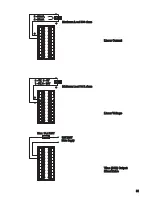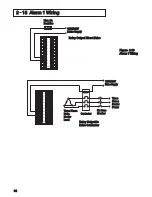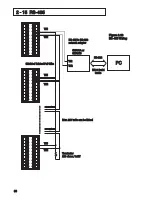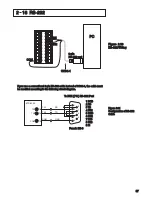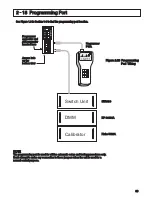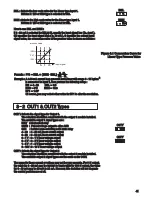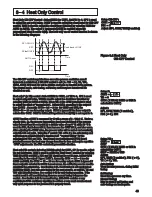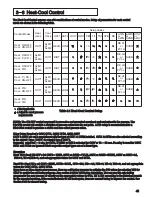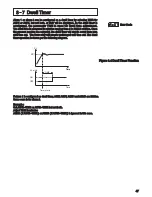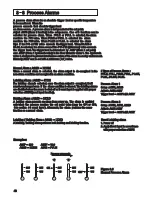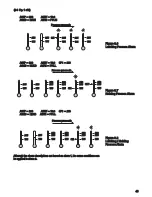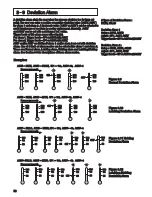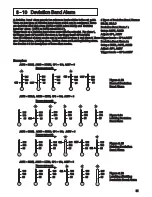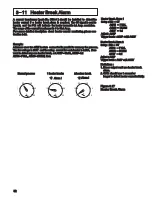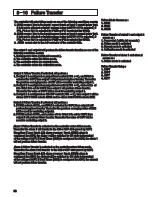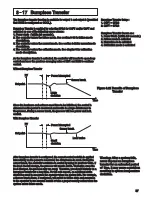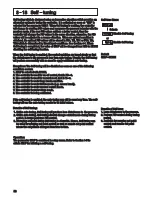
3 4 Heat Only Control
3 4 Heat Only Control
Heat Only ON-OFF Control : Select REVR for OUT1, Set PB1 to 0, SP1 is used
to adjust the set point value, O1HY is used to adjust the dead band for ON-OFF
control, TIME is used to adjust the dwell timer (enabled by selecting TIMR for
A1FN or A2FN). The output 1 hysteresis(O1HY) is enabled when the
proportional band is set to 0(off). The heat only on-off control function is shown
in the following diagram :
Heat Only ON-OFF Control : Select REVR for OUT1, Set PB1 to 0, SP1 is used
to adjust the set point value, O1HY is used to adjust the dead band for ON-OFF
control, TIME is used to adjust the dwell timer (enabled by selecting TIMR for
A1FN or A2FN). The output 1 hysteresis(O1HY) is enabled when the
proportional band is set to 0(off). The heat only on-off control function is shown
in the following diagram :
SP1+O1HY/2
SP1 O1HY/2
SP1
ON
OFF
OUT1 Action
PV
Dead band = O1HY
Time
Time
The ON-OFF control may introduce excessive process oscillation even if
hysteresis is minimized. If ON-OFF control is set ( ie. PB1 = 0 ), TI1, TD1,
CYC1, OFST, CPB and PL1 will be hidden and have no function to the system.
The manual mode, auto-tuning, self-tuning and bumpless transfer will be
disabled as well.
Select REVR for OUT1, set TI1 to 0, SP1 is used
to adjust set point value, TIME is used to adjust the dwell timer (enabled by
selecting TIMR for A1FN or A2FN). When TI1=0 the OFST parameter is used
to adjust the offset or “manual reset”. Adjust CYC1 according to the output 1
type (O1TY) .Generally, CYC1= 0.5 ~ 2 sec for SSRD and SSR, the
CYC1=10 ~ 20 sec for a relay output. CYC1 is ignored if the linear output is
selected for O1TY.
if Proportional band(PB1) is not equal to 0.
OFST is measured by % with a range of 0 - 100.0 %. Under a
steady state, (ie. the process temperature has been stabilized) if the process
value is lower than the set point by a definite value of say 5 °C, while 20 °C is
used for PB1, that is lower 25 %, then increase the OFST 25 %, and vice versa.
After adjusting the OFST value, the process value will be varied and eventually,
coincide with set point. Using the P control ( TI1 set to 0 ), the auto-tuning and
self-tuning are disabled.Refer to Section 3-20 " manual tuning " for the
adjustment of PB1 and TD1. The Manual reset adjustment (OFST) is not
practical because the load may change from time to time and require repetitive
OFST adjustments. The PID control will prevent this situation.
Selecting REVR(heating) for OUT1, SP1 is used to adjust
the set point value. TIME is used to adjust the dwell timer ( enabled by selecting
TIMR for A1FN or A2FN ). PB1 and TI1 should not be set to zero. Adjust CYC1
according to the output 1 type ( O1TY ). Generally, CYC1 = 0.5 ~ 2 sec for
SSRD and SSR, the CYC1 = 10 ~ 20 sec for a relay output. CYC1 is ignored if
linear output is selected for O1TY. In most cases, the self-tuning can be used to
substitute the auto-tuning. See
If self-tuning is not used (select
NONE for SELF), then use auto-tuning for the new process, or set PB1, TI1 and
TD1 with historical values. See section 3-19 for auto-tuning operation. If the
control result is still unsatisfactory, then use manual tuning to improve the
control . See Section 3-20 for manual tuning.
-
contains a
algorithm to achieve a
to the process if it is properly tuned.
Heat only P (or PD) control :
O1HY is hidden
OFST Function :
Heat only PID control :
Section 3-18.
ETR 8300
very
sophisticated PID and Fuzzy
very small overshoot and
very quick response
The ON-OFF control may introduce excessive process oscillation even if
hysteresis is minimized. If ON-OFF control is set ( ie. PB1 = 0 ), TI1, TD1,
CYC1, OFST, CPB and PL1 will be hidden and have no function to the system.
The manual mode, auto-tuning, self-tuning and bumpless transfer will be
disabled as well.
Select REVR for OUT1, set TI1 to 0, SP1 is used
to adjust set point value, TIME is used to adjust the dwell timer (enabled by
selecting TIMR for A1FN or A2FN). When TI1=0 the OFST parameter is used
to adjust the offset or “manual reset”. Adjust CYC1 according to the output 1
type (O1TY) .Generally, CYC1= 0.5 ~ 2 sec for SSRD and SSR, the
CYC1=10 ~ 20 sec for a relay output. CYC1 is ignored if the linear output is
selected for O1TY.
if Proportional band(PB1) is not equal to 0.
OFST is measured by % with a range of 0 - 100.0 %. Under a
steady state, (ie. the process temperature has been stabilized) if the process
value is lower than the set point by a definite value of say 5 °C, while 20 °C is
used for PB1, that is lower 25 %, then increase the OFST 25 %, and vice versa.
After adjusting the OFST value, the process value will be varied and eventually,
coincide with set point. Using the P control ( TI1 set to 0 ), the auto-tuning and
self-tuning are disabled.Refer to Section 3-20 " manual tuning " for the
adjustment of PB1 and TD1. The Manual reset adjustment (OFST) is not
practical because the load may change from time to time and require repetitive
OFST adjustments. The PID control will prevent this situation.
Selecting REVR(heating) for OUT1, SP1 is used to adjust
the set point value. TIME is used to adjust the dwell timer ( enabled by selecting
TIMR for A1FN or A2FN ). PB1 and TI1 should not be set to zero. Adjust CYC1
according to the output 1 type ( O1TY ). Generally, CYC1 = 0.5 ~ 2 sec for
SSRD and SSR, the CYC1 = 10 ~ 20 sec for a relay output. CYC1 is ignored if
linear output is selected for O1TY. In most cases, the self-tuning can be used to
substitute the auto-tuning. See
If self-tuning is not used (select
NONE for SELF), then use auto-tuning for the new process, or set PB1, TI1 and
TD1 with historical values. See section 3-19 for auto-tuning operation. If the
control result is still unsatisfactory, then use manual tuning to improve the
control . See Section 3-20 for manual tuning.
-
contains a
algorithm to achieve a
to the process if it is properly tuned.
Heat only P (or PD) control :
O1HY is hidden
OFST Function :
Heat only PID control :
Section 3-18.
ETR 8300
very
sophisticated PID and Fuzzy
very small overshoot and
very quick response
Figure 3.2 Heat Only
ON-OFF Control
Figure 3.2 Heat Only
ON-OFF Control
Setup ON-OFF :
Adjust :
OUT1 =
PB1 = 0
SP1, O1HY, TIME(if enabled)
Setup ON-OFF :
Adjust :
OUT1 =
PB1 = 0
SP1, O1HY, TIME(if enabled)
Setup P:
OUT1 =
TI1 = 0
CYC1 ( if RELAY, SSRD or SSR is
selected for O1TY )
Setup P:
OUT1 =
TI1 = 0
CYC1 ( if RELAY, SSRD or SSR is
selected for O1TY )
Adjust :
SP1, OFST, TIME ( if enabled ),
PB1 ( = 0 ), TD1
Adjust :
SP1, OFST, TIME ( if enabled ),
PB1 ( = 0 ), TD1
Setup PID :
Adjust:
OUT1 =
O1TY
CYC1 ( if RELAY, SSRD or SSR is
selected for O1TY )
SELF = NONE or YES
SP1, TIME ( if enabled ), PB1 ( = 0 ),
TI1 ( = 0 ), Td1.
Setup PID :
Adjust:
OUT1 =
O1TY
CYC1 ( if RELAY, SSRD or SSR is
selected for O1TY )
SELF = NONE or YES
SP1, TIME ( if enabled ), PB1 ( = 0 ),
TI1 ( = 0 ), Td1.
Auto-tuning:
Used for new process. during initial
tuning
Auto-tuning:
Used for new process. during initial
tuning
Self-tuning:
Used for a process any time.
Self-tuning:
Used for a process any time.
Manual Tuning:
May be used if self-tuning and
auto-tuning are inadequate.
Manual Tuning:
May be used if self-tuning and
auto-tuning are inadequate.
43



